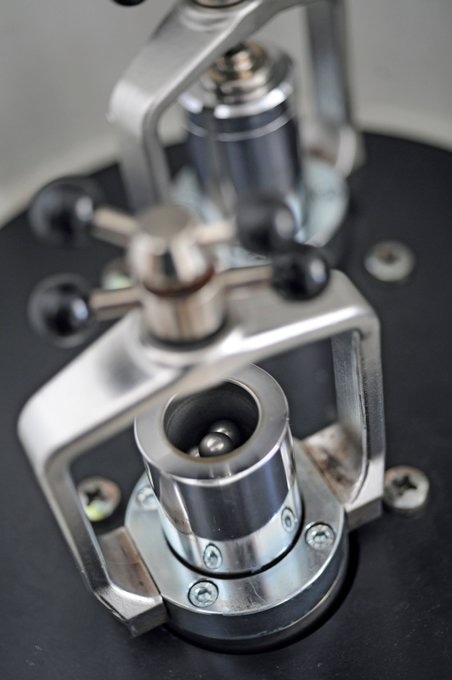Oct 31 2019
At the Max-Planck-Institut für Kohlenforschung in Mülheim an der Ruhr, chemists have identified a new method to synthesize a nanoparticle form of corundum by employing simple mechanochemistry in a ball mill.
 Chemistry in the ball mill: Researchers in Mülheim grind substances such as boehmite in order to convert them mechanochemically. They can thus obtain nanoparticles of corundum from boehmite. (Image credit: © Frank Vinken)
Chemistry in the ball mill: Researchers in Mülheim grind substances such as boehmite in order to convert them mechanochemically. They can thus obtain nanoparticles of corundum from boehmite. (Image credit: © Frank Vinken)
Thanks to this latest breakthrough, materials for dental implants and automotive catalysts, among others, can be manufactured more easily and in a more robust way than ever before.
Also known as alpha-alumina, corundum is a specifically stable variant of alumina. The nanoparticles can be utilized, among other things, as a raw material for specifically hard ceramics or as a resistant carrier material in automotive catalysts. By using the Mülheim process, a first industrial firm is already working on the commercial production of nanocorundum.
The corundum, in its most precious variants, creates sapphires and rubies as a result of traces of titanium, iron, or chromium. Material scientists, however, are not too keen on it as a gemstone.
In terms of hardness, corundum can almost compete with diamond, and also has excellent resistance to chemicals and heat. Therefore, it is used for cutting tools, for ceramic implants in dentistry and prostheses, as well as in catalysis.
If ceramics are made from corundum nanoparticles, they can be made much stronger. A manufacturing process like that would also need minimal energy. Moreover, corundum nanoparticles can make it easy to construct automotive catalysts, whose catalytically active components would subsequently become more stable. Until now, the automotive sector has been utilizing a less stable form of alumina in a complicated process.
Corundum Nanoparticles Will Make Some Reactions More Efficient
The nanoparticle form of corundum is highly appealing to the chemical sector.
There are reports that catalysts with a carrier material made of corundum work more efficiently for the production of ammonia. In other catalytic processes, such as the production of synthetic fuels, the higher stability could be essential.
Ferdi Schüth, Director, Max-Planck-Institut für Kohlenforschung
Therefore, corundum in nanoparticulate form could be used in many upcoming applications, as it can now be easily accessed via the simple mechanochemical procedure discovered by the Mülheim chemists.
A powder of the corundum nanoparticles can now be obtained by the researchers. This powder is acquired by merely grinding lumps of boehmite in a ball mill for three hours, and subsequently heating them for a short time. Boehmite is an aluminum oxyhydroxide contained in the bauxite ore that occurs naturally.
To date, chemists have only synthesized corundum from other aluminum hydroxides or oxides by pressurizing the starting materials at milder temperatures of 500 °C for weeks, or firing them at temperatures beyond 1200 °C. However, following the high-temperature treatment, larger crystals developed instead of the required nanoparticles.
“We discovered by chance that nanoparticles of corundum are produced in a ball mill,” added Ferdi Schüth.
Ferdi Schüth’s research team analyzed whether a catalytic reaction in such a ball mill actually works better, since the catalyst is invariably given a fresh surface where the reactants can meet.
The researchers applied soft alumina, or gamma-alumina, combined with gold particles as a catalyst, and tracked the process in the ball mill through numerous analytical techniques. After just a few hours, it was demonstrated that part of the soft alumina had been changed into corundum. But the corundum achieved this way from the soft alumina had moderate nanocrystallinity.
But, this raised our expectations and we then systematically investigated this and tested several variants of alumina and aluminium (oxide)hydroxides as starting materials. Eventually, we identified boehmite as a particularly interesting precursor due to its structural water.
Amol Amrute, Lead Project Scientist, Max-Planck-Institut für Kohlenforschung
Potential Customers have Expressed Interest
Currently, chemists can explain why a process as insignificant as grinding paves the way for a mineral that can only be realized under aggressive circumstances and definitely not in nanoparticulate form.
The shocks experienced by the precursor boehmite in the ball mill offers the precise mechanical energy required for converting the boehmite structure to corundum, which is a rather complicated process.
The Mülheim scientists, who are experts in the development of novel catalysts, are currently exploring how the nanoparticle form of corundum is utilized as a catalyst material in numerous reactions, for example, in the development of synthetic fuel.
We don’t necessarily expect a completely different reaction behavior.
Ferdi Schüth, Director, Max-Planck-Institut für Kohlenforschung
Since corundum is relatively more stable, this alumina in nanoparticulate form may speed up certain reactions much more than the previously used forms of alumina.
First industrial firms are aware of the simple technique used for producing corundum nanoparticles. Prospective customers have already shown their interest, and a process is presently being created to synthesize large amounts of the nanoparticulate corundum.